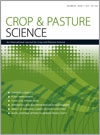CP17171Evaluation of spray nozzles for fungicidal control of tan spot in wheat
Three nozzles with droplet size between c.a.180 to 500 μm were evaluated in the control of tan spot caused by Pyrenophora tritici-repentis (Died.) Drechs. in three wheat cultivars. The use of drift reducing nozzles and a systemic fungicide led to satisfactory performance in the spray deposition, canopy penetration, yield grain, and control of the tan spot disease of wheat in the same way as could be expected from conventional nozzles.




